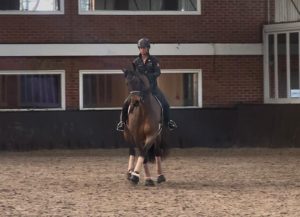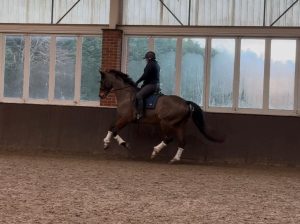Report from the Judy Harvey FBHS Dressage Training at the F&I Annual Course 2025
 It was good to see so many horses, riders and spectators braving the somewhat challenging conditions to make the trip to Addington for one of the highlights of the F&I calendar.
It was good to see so many horses, riders and spectators braving the somewhat challenging conditions to make the trip to Addington for one of the highlights of the F&I calendar.
Judy was equipped with a headset to easily communicate with her riders, a microphone to be heard by the spectators over the excitement coming from the jumping next door, a heater plugged in in the corner and enough layers of clothing to rival an onion.
Over the two days, we saw combinations at various stages in their training ranging from Novice to Grand Prix. Judy allowed each of them to work in as they normally would and questioned them on what they were feeling, adding her thoughts and observations. It was interesting to hear what Judy picked up on through the eyes of a judge as well as a trainer and then watch her lead the rider through exercises to further develop the quality of the way of going. Often the simplest of tips were enough to have a big impact, such as not trying to ride further into corners but to ride them with better bend.
There was a strong theme for all horses having to be ridden forward enough and that ‘forward is the exit’. Working through the gears of each pace helped to ensure that the horses were in front of the leg and more active in the hindleg. This subsequently created more suspension meaning higher marks would be available. This work promoted discussion on the importance of regular breaks for the horse to prevent possible tension and anxiety.
 For some combinations, this meant that they were riding more positively forward than maybe they would normally, thus creating a stronger, maybe heavier feeling in the rein. Judy helped in these cases to invite the horses to look after their own balance better and maintain a more open frame with timely releases of the rein. David Llewellyn’s horse had been particularly hot in this environment but reacted very well to these releases of the rein, which Judy confirmed with the comment ‘See? Nobody died!’
For some combinations, this meant that they were riding more positively forward than maybe they would normally, thus creating a stronger, maybe heavier feeling in the rein. Judy helped in these cases to invite the horses to look after their own balance better and maintain a more open frame with timely releases of the rein. David Llewellyn’s horse had been particularly hot in this environment but reacted very well to these releases of the rein, which Judy confirmed with the comment ‘See? Nobody died!’
Attention was paid to the quality of the halt transitions by focussing on the balance, collection and reaction to the transition. Judy said that often horses can move in the halt as they are waiting to be adjusted or corrected so it would be better to ride a fresh halt with a better transition in.
Several riders worked on the half passes in the PSG and Inter I tests and Judy highlighted the importance of accuracy in order to promote the best balance and positioning. There was a clear difference in the quality of the changes and ease of fitting the movements into the arena because of this. Judy explained that when introducing horses to the zig zag, it is best to ride the change when you feel the correct moment of balance, regardless of number of strides or positioning in the arena as this will help to produce good changes from the start.
Judy explained that the piaffe pirouette is often seen as being a difficult movement but that actually using the thought of working towards this can be incredibly useful. By keeping the horse turning through the piaffe in the middle of the arena, they have to keep their feet moving and we saw improvements in the quality of the steps and the horses naturally being inclined to draw more forward to the contact.
There were so many useful ideas and discussions to be had that many people will have headed home with great inspiration for their riding and coaching for the year ahead!
Report by Dan Spencer BHSI, Laurel Cooke BHSI and Chris Gillison BHSI
